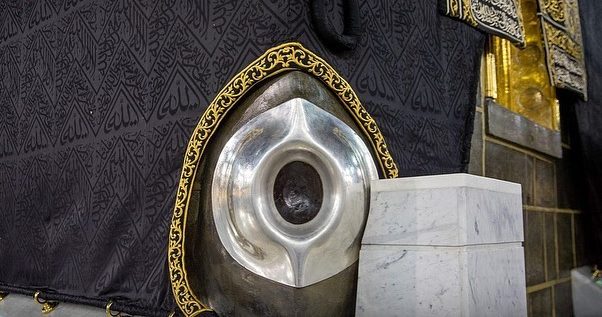The Black Stone marks the beginning and end of circumambulation during pilgrimage, though its significance transcends this.
With hearts filled with faith and devotion to their creator, millions of Muslims congregate in Makkah, the holiest place in Islam, for the Hajj season.
The pilgrimage season is one that allows worshippers to pour all of their life’s worries out through prayers, rituals and supplications to their Lord, seeking rewards in this life and the hereafter.
When circumambulating the Ka’bah during tawaf, the minds and hearts are dedicated the greatness of God, as with each round worshippers are advised to praise God, then pray for themselves, their families and loved ones, and seek God’s counsel and refuge in this life, and what Muslims believe to be the punishment of hellfire in the after life.
During the tawaf, some worshippers attempt to touch and kiss the sacred Black Stone or as known in Arabic, Al Hajar Al Aswad, in the corner of the Ka’bah, as various narrations claim the Prophet Muhammed used to do.
Often, the area by the Black Stone is most congested, with hands outreaching towards the stone and various security guards standing nearby to ensure order.
Preserved by an oval frame made out of pure silver, the Black Stone marks the beginning and end of the tawaf, though its significance transcends just this.
What is the Black Stone?
Various narrations in the Islamic tradition note that the Black Stone is a holy relic brought down from the heavens by the angel Jibrael to Prophet Ibrahim as he was constructing the Ka’bah.
It is believed that upon looking for the final brick or stone to lay onto the Ka’bah, the angel descended upon the prophet with the stone. Since the Ka’bah has been destroyed, renovated and reconstructed many times over the centuries, many believe that the black stone is the last remaining relic of the original building.
Several ahadith cite Prophet Muhammad saying that the stone was originally white before it was blackened by “mankind’s sins”.
Historians believe that the stone is composed of 15 pieces, of which seven are attached by brown paste made of wax and musk that are visible to pilgrims.
Are pilgrims obligated to touch it?
With every tawaf, pilgrims are obligated to raise their hands towards the Black Stone while saying the takbir, or magnification of Allah.
While some rush to kiss or touch the Black Stone, it is not obligatory to do so but is rather a Sunnah: an act emulating the actions of Prophet Muhammad.
In one hadith, Umar Ibn Al-Khattab, the second Muslim caliph is reported to have said: “You’re just a stone that does not benefit or harm anyone, and if I hadn’t seen the Prophet (peace and blessings be upon him) kissing you, I would have not done so.”







